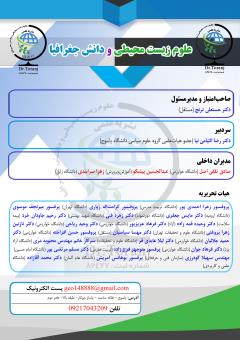مطالعه بعد طبیعی آفرینش از دیدگاه قرآن
محورهای موضوعی : religious Sciences
1 - دانشگاه حوزه ی علمیه حضرت معصومه سی سخت
کلید واژه: آفرینش جهان خلقت, طبیعت, دیدگاه قرآن, بعد طبیعی آفرینش,
چکیده مقاله :
هر چند از دیدگاه قرآن، هدف نهایی طبیعت شناسی، افزودن معرفت انسان ها نسبت به خداوند و تقرّب به اوست، امّا با بررسی و مطالعه ایات قرآنی، این نکته به دست می اید که قرآن از پرداختن به پدیده های طبیعی، اهداف متوسطی را نیز دنبال نموده است که لازمه و مقدّمه رسیدن به آن هدف نهایی به حساب می ایند این پژوهش به دنبال آن است تا با مطالعه بعد طبیعی آفرینش از دیدگاه قرآن به دست آورد و در ادامه عملکرد بعد طبیعی را در تعامل با چرخه هستی به بحث گذاشته و کلیتی نمودار گونه از روند آفرینشی وی ترسیم نماید. در این راه از روش تحلیلی - تفسیری بهره گرفته شده است که جمع آوری مطالب نیز به صورت کتابخانه ای و میدانی انجام گرفته است. در پایان این مطالعه نشان می دهد، همان گونه که خداوند با دمیدن روح خلاقه خود در جسم بی جان ، آدمی را می آفریند؛ انسان نیز در مقام جانشین وی با دمیدن روح خلاقـه خـود در کالبـد مـواد خام و بی جـان بـه آنها زندگی می بخشد و بدین سان هنر از انسان زاییده می شود. در طول تاریخ خلقت، طبیعت، گاه خدای انسان و گاه ابزار انسان بوده است. انسان، همواره یا سوار بر طبیعت است و از مظاهر آن، نهایت استفاده را می برد و یا به شدّت، مسحور طبیعت می شود و طبیعت، او را رام خویش می کند و حتّی زندگی او را دستخوش تغییرات اساسی قرار می دهد. بر همین اساس است که رابطه انسان و طبیعت باید با شناخت درست از طبیعت و بر اساس معیارهای عقلانی ترسیم شود.
"Creation" is the act of God Almighty, and creativity is also His attribute, but since God created man in His own image and breathed a soul into his flower, by virtue of being the Khalifa of God, he should be ascribed to the attributes of God and the manifestation of God's names and attributes. be on the ground This research seeks to obtain a road map for the creation and creation of works of art and especially architecture by comparing the process of creation of nature from the perspective of the Holy Qur'an, and further discusses the performance of an architect in interaction with the cycle of existence and the generality of the diagram. Draw his creative process. In this way, the analytical-interpretive method has been used, and the collection of materials has been done in the library and field. At the end of this study, it shows, just as God creates a person by breathing his creative spirit into an inanimate body; Man, as his successor, breathes his creative spirit into the body of raw and inanimate materials and gives life to them, and thus art is born from man. On the other hand, creation is always done as a process, and in all stages of creation, opposing elements always exist alongside each other and have an evolutionary role for each other; A kind of diversity that all come from a current source and evolve together. In other words, it can be said: in creation; God has revealed the connection with similitude and with tension; It has given identity and personality to every element.
1-Ghobadian, V.; (2004) The Principles and Concepts of Western Current Architec- ture; Vol.2; Tehran, Cultural Research Office
2-Noghrekar, A.; (2009) The Man, the Nature, the Architecture; Tehran, Payame-noor University.
3-Golparvarfard, N.; (2009) The Man, the Nature, the Architecture; Tehran, Tahan.
4-Mehr News Agency; (2013) http://www. mehrnews.com/search?q=2096398; July14.
5-Ragheb-Esfahani, H.; (1981) Almofaradat fi Gharibe-alquran; Khosravi Hossainy, Gh.; 3rd ed.; Tehran, Mortazavi.
6-The Holy Quran, Ebrahim, 24.
7-The Holy Quran, Ghaf,9.
8-The Holy Quran, Foselat,11.
9-The Holy Quran, Sajde,5.
10-Moosavi Hamedani, M. B.; (1995) The Translation of Tafsere-almizan; Vol.5;
Issue16; Qum, Islamic Publication of Hoza Scholars.
11-The Holy Quran, Hood,65.
12-The Holy Quran, Ebrahim,5.
13-The Holy Quran, Baghare,113.
14-The Holy Quran, Zariat.56.
15-The Holy Quran,Najm, 42.
16-Al-Esfahani, M.M.T; (2000) Makiale-alma- karem; Beirut, Alelmi Assosiation.
17-The Holy Quran, Asra, 17.
18-Tabarsi, A.; (1994) Majmaolbayan fi TafsirelQuran; Vol. 6; Beirut, Moases alelmi lelmatbouat.Tabatabaee, M. H.;(1970)
19-Khomaini, M.; (1997) The Holy Qoran In- terpretation; Khomaini Assosiation; Vol.4.
20-Farsinejad, A., Dejabadi, H.; (2009) The Philosophy behind the Creation of the World and Human from Quran Perspec-tive; Issue 30; Shiraz, Andishe Dini Quar- terly.
21-Grouter, Y.; (1987) Aesthetics in Architec- ture. Pakzad, J. and Homayon, A.; Tehran, Shahid Beheshti University.
22-Tofighi, H.; (2005) Knowing Great Reli- gions; Tehran, SAMT.
23-Tabatabaee, M. H.; (1996) Tafsir-almizan; Moosavi Hamedani, M. B.; Qum, Islamic Publication Office.
24-Shaygan, D.; (1990) Henry Corbin: the ho- rizons of spiritual thinking within Iranian
Islam; Parham, B.; Tehran, Nashre-farzan.
25-Ridgeon, L.; (1998) Aziz Nasafi; Kayvani, M.; Tehran, Nashre-markaz.
26-Falamaki, M. M.; (1986) The Indigenous Architecture in Iran; Tehran, Faza Scien-
tific and Cultural Assossiation.


